Reminiscences 2025
Another add-on trip with David went in 2006 to another of the ancient capitals of China—Kaifeng. That trip was enlightening, too. As I looked at what was happening in China, I realized that China was improving infrastructure and rebuilding historical sites. Unlike the Cultural Revolution, when only an impassioned intervention from Zhou En-lai saved the Forbidden City, the Chinese were burnishing places like the palace at Kaifeng. In Kaifeng, for example, David and I went to the sites commemorating the Jewish Community in Kaifeng—yes, along the Silk Road, Jewish and Muslim merchants plied their trade. The site of the old synagogue had been replaced by a church; that church, in turn, was the early 20th century home of a Canadian Bishop, who was also a collector. Remnants of the Muslim/Jewish period are in the Royal Ontario Museum.
Hello from Luoyang
May 25. 2006
The last 24 hours were frantic, but as JR can tell you, traveling with two people is a lot different than with 29!
The flight to Beijing was uneventful, but I think I told you we were being transferred to a train for an overnight ride into central China, to the city of Luoyang.
We arrived in Beijing around 3 pm, and had until 10:30 to wander—with a 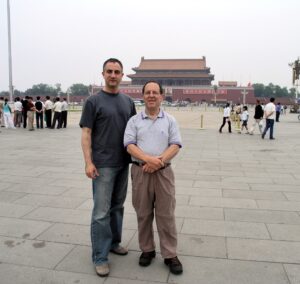 guide who was quite agreeable. She took us to Tiananmen Square (largest public place in the world–no one was watching us, Kevin Eack, except some of your CIA types!), and to my great surprise few people
guide who was quite agreeable. She took us to Tiananmen Square (largest public place in the world–no one was watching us, Kevin Eack, except some of your CIA types!), and to my great surprise few people
were there. When I have been there in the past, it’s been mobbed. I also learned that there’s a flag ceremony in the evening, when they take down the flag—and I’ve been getting folks up at sunrise (4:30 here) when we could be going to the square at 7 at night…..Glad no one found out!
The guide asked about a meal, and took us to a Shanxi restaurant, where we ate cat ears. Before you think this is standard fare in China, let me tell you that it is not “cat ears,” but a pasta dish shaped like cat ears (least I hope it was!). Dinner for four cost $15, which told me we were no longer in Hong Kong.
We still had some time, so the guide took us to a Beijing Opera performance. If you have never seen “Farewell my Concubine,” the film is a great introduction to Chinese opera. It is a combination of acrobatics and high-pitched singing, banging gongs, and a whole lot more fun than it sounds.
Then to the train station, where 9 million people gather. Fortunately, there is a separate waiting room for the “soft sleeper” passengers, and I have learned that is the best way to travel in China on an overnight train–it’s only 4 to a compartment. We settled in at 11:30 for the ride, which got us to Luoyang at 9:30 this morning.
David likes North China–he says it is more like Illinois in food, and looking out the window, he remarked, “We’re in Indiana.” They grow some corn, but lots of wheat that is featured in noodle dishes (and cat ears!).
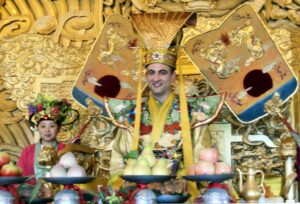 Luoyang is a “small city” of 2 million, with around 6 million total in the suburbs. It’s a grey city, but like most Chinese cities, has increased splashes of color recently. It was prominent in the past, one of 8 cities (can you name the others) that served as capital of China. It accommodated 12 dynasties, most recently the northern Sung in the 10th century, which was way before my time.
Luoyang is a “small city” of 2 million, with around 6 million total in the suburbs. It’s a grey city, but like most Chinese cities, has increased splashes of color recently. It was prominent in the past, one of 8 cities (can you name the others) that served as capital of China. It accommodated 12 dynasties, most recently the northern Sung in the 10th century, which was way before my time.
Yes, before MY time.
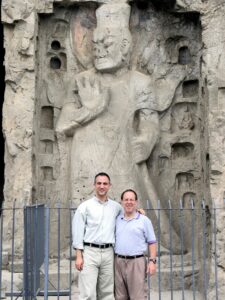
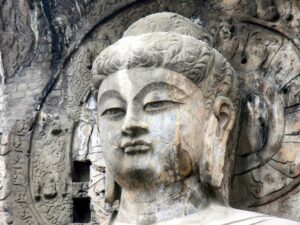
The Longmen grottoes–Buddhist caves with statues carved by emperors, their concubines currying favor, empresses, and officials–are world class, and dominate two sides 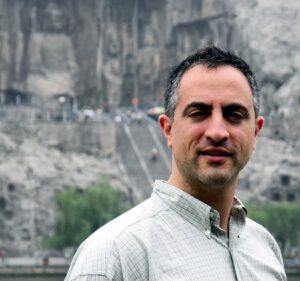
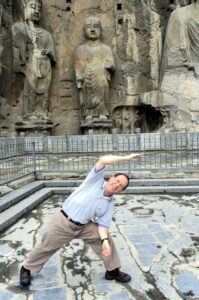 of the Yi River. I shot about 50 digital shots, and probably will keep 49. The Tang statues are plump, the Northern Wei slender, so I will be able to tell them apart. Maybe.
of the Yi River. I shot about 50 digital shots, and probably will keep 49. The Tang statues are plump, the Northern Wei slender, so I will be able to tell them apart. Maybe.
There were two other major sights on the itinerary. In talking with the guide, I learned the Guang Gong is buried here–at least 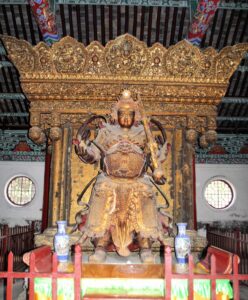 his head is. He is the statue I collect since I think he is fiercer than Tommy Titan, and I’d like to use the GG as the IWU mascot. He was a general in the period of the Three Kingdoms, and he was slain. His head was sent to the emperor at Luoyang, who attached a wooden body (!) and buried him with honors. There is now a temple on the spot that dates (in its present form) from the Ming dynasty (1500s),
his head is. He is the statue I collect since I think he is fiercer than Tommy Titan, and I’d like to use the GG as the IWU mascot. He was a general in the period of the Three Kingdoms, and he was slain. His head was sent to the emperor at Luoyang, who attached a wooden body (!) and buried him with honors. There is now a temple on the spot that dates (in its present form) from the Ming dynasty (1500s),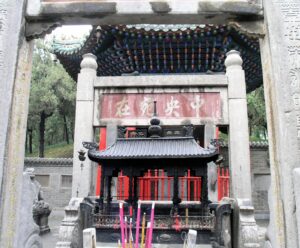 that is a quiet spot in a noisy world. The Guang Gong is a symbol of loyalty (a scout is loyal!). I’ll show you the statue I bought here.
that is a quiet spot in a noisy world. The Guang Gong is a symbol of loyalty (a scout is loyal!). I’ll show you the statue I bought here.
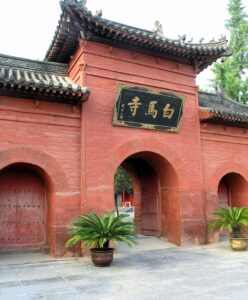 The other place dates from around 65 BC, when the first Indian monks brought Buddhism to China, to the White Horse Temple. After getting through the hawkers who wanted to sell us things we did not want, including pictures on a white horse that they told us (at least I think that was their Chinese) had brought the sutras back from India to Luoyang, the temple was one of the best preserved I’ve seen in China.
The other place dates from around 65 BC, when the first Indian monks brought Buddhism to China, to the White Horse Temple. After getting through the hawkers who wanted to sell us things we did not want, including pictures on a white horse that they told us (at least I think that was their Chinese) had brought the sutras back from India to Luoyang, the temple was one of the best preserved I’ve seen in China.
In other words, though Luoyang is only #9 on the list of places to visit in China, it is really a pretty neat place.
The sun finally peaked out this afternoon for the first time in a week. Hope it stays!